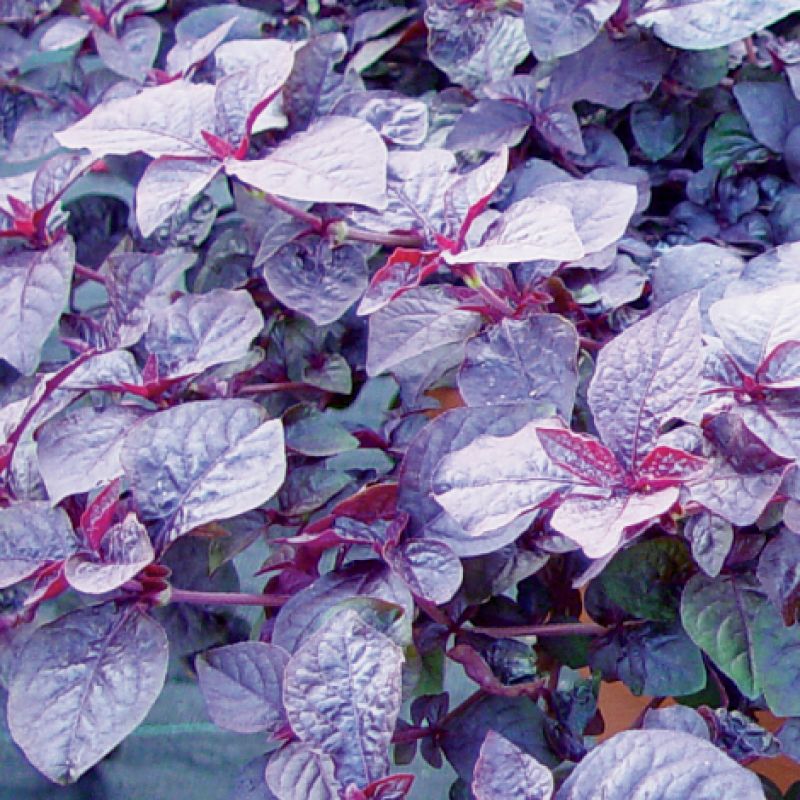
Can you imagine making salsa without fresh cilantro or a julep without mint? We didn’t think so. Instead of heading to the store when a recipe calls for herbs, grow your own. They thrive in containers—as solos or in delicious combinations. Harvest them often to brighten your favorite dishes or combine the fragrant, fresh cuttings with flowers in beautiful centerpieces.
In general, most herbs require approximately six hours of sunlight and well-draining soil. However, when you combine multiple kinds in the same container, make sure that they have similar light and water needs. Try this great trio, including a spiller (lemon thyme), a thriller (purple basil), and a filler (garlic chives).
Lemon thyme
(Thymus x citriodorus ‘Aureus’)
This fragrant perennial has beautiful variegated foliage that thrives in full sun and can cascade up to eight inches over the edge of its container. As a woody herb, it benefits from frequent harvesting, which encourages good air circulation. Pinch back to promote branching. Lemon thyme delivers beauty all year long and adds a refreshing citrus flavor to marinades, vegetables, tea, and even cookies.
Hardiness: Garlic chives, zones 4-9 Lemon thyme, zones 5-9
Light: Full sun
Soil: Well-draining, sandy, loamy
Water: If the soil feels dry at a depth of one inch, water thoroughly at the soil line until water runs out the bottom of the pot. Check frequently as herbs mature.
Fertilize: Sparingly so that herbs will retain flavor
Maintain: Harvest often to encourage new growth.
Garlic Chives
(Allium tuberosum ‘New Belt’)
Also known as “Chinese chives,” this perennial can be grown by seed but takes up to a year to establish. Instead, purchase transplants in the spring to harvest right away. Flat leaves, which have a mild garlic flavor, stand 15 to 18 inches tall and set a beautiful white bloom in summer that’s also a perfect edible addition to a salad.
Purple Basil
(Ocimum basilicum ‘Purpurascens’)
This variety of the classic summertime annual reaches 18 to 24 inches in height and gives quite a show with its deep purple leaves. Harvest it frequently to keep in scale and minimize water demands. If it becomes woody, cut back by one-third to encourage a fresh flush of growth. Basil roots well by vegetative cutting, and its leaves are excellent in sauces and with fish, lamb, and poultry.
Harvesting and Watering Tips
Harvest your herbs early, after the dew has dried, but before the sun heat takes hold. This is when they will retain the most flavor. Herbs benefit greatly from routine harvest. Cut the stems to harvest leaves this will stimulate compact new growth and keep them from setting seed. Most herbs prefer lean soil; over fertilizing can result in vigorous growth that lacks flavor. Check for water daily by placing a finger an inch below the soil line. Water until the water flows through the bottom of the pot. Herbs can be pruned back to alleviate water needs.
More Herbs To Grow!
Cilantro
(Coriandrum sativum ‘Confetti’)
Growing this cool-season annual during our hot summers can be a challenge. When temperatures climb upwards of 80 degrees, cilantro will bolt (seed prematurely). Start sowing the seed in the spring while temperatures are cool. The ‘Confetti’ variety is slow to bolt and has a milder flavor. It prefers full sun and can be harvested four weeks after sowing. Once it bolts, flowers, and sets seed, collect seed to use as coriander. When the heat is on, try planting Vietnamese coriander (Polygonum odoratum) as a cilantro substitute. It has a slightly different flavor but can impart that needed kick for fresh salsa.
Light: Full sun
Soil: Loamy
Water: Well-drained to moist
Harvest: Approximately 28 days after planting
Mint
(Mentha spicata ‘Kentucky Colonel’)
Mint grows in many different varieties and flavors, such as orange, chocolate, pineapple, and ginger, just to name a few. The traditional mint that is muddled in our juleps is a spearmint called ‘Kentucky Colonel’ that’s prized for its sweet flavor. As with most mints, Kentucky Colonel is a vigorous grower and can take over when planted in the garden. Grow it in a container alone so that is does not choke out its neighbors. Mint prefers its soil to be moist and grows well in partial shade. If allowed to bloom the flavor will change so harvest frequently. Root by runner every few seasons to keep flavor fresh.
Light: Partial shade
Soil: Loamy
Water: Keep moist
Harvest: Frequently